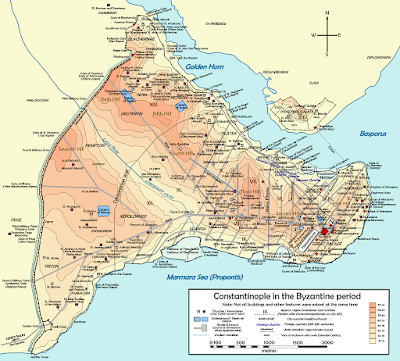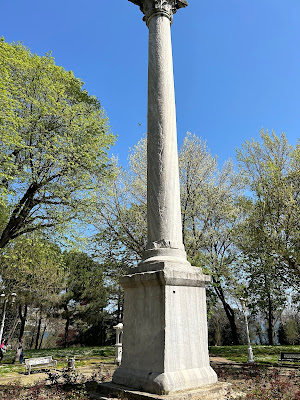Peppered throughout Istanbul are isolated items of her Roman and Byzantine past.
An A.D. 6th Century writer notes that the column at one time had a statue of Tyche (Fortuna) on top.
The script, now much faded, suggests a memorial to a victory over the Goths.
The Column of Constantine was moved by Constantine I in the year A.D. 330 from the temple of Apollo in Rome. Originally surmounted by a statue of Apollo, it was replaced over the years by statues of Constantine, Julianus, and Theodosius. Destroyed in A.D. 1081, it was rebuilt and a cross placed on top by Alexius I Comnenus. The cross remained until A.D. 1453 and the Ottoman Conquest. In the late A.D. 1600's to early 1700's, the column was damaged by fire. A wall was put under the column and iron rings bound it.
Interestingly, at least one story has relics of Christ being buried under the column.
 |
| (Source) |
Byzantium and Constantinople were protected by walls through most of its history; it was these walls that allowed it to survive multiple sieges (it was ultimately the gunpowder era that overcame them). The walls of the original Acropolis were expanded by the Emperors Severus and Constantine I and his son Constantius (A.D. 317 - 361). The walls were a single wall - which the expanding city quickly outgrew.
The single Constantinian walls was replaced by the Emperor Theodosius with an inner wall, an outer wall, a low wall and a moat.
 |
| (Source) |
The walls, once built, secured the city - but were often prey to earthquakes, needing multiple repairs. After the sack of Constantinople in A.D. 1204, the walls were more often than not in disrepair. Only the threat of attack was enough to get them in better condition. And yet, even at that, they withstood a 53 day siege before the Ottomans took the city - almost 1,000 years of service.
These walls are part of the Old Inner City and stand by the Topkapi Palace. All of the Walls - or what was left of them - stood throughout the Ottoman Era.
These last set of walls were not half a mile from our hotel. I have no idea what walls they are - there was no indication on any map and no marker. A small park is there now and a small mosque. The day I came the sun was setting and families who had make a picnic of the day were preparing a barbecue or packing up to leave.
As they had for perhaps 1600 years the walls stood, silently watching.
 |












Another excellent post TB, that's a lot of stone quarried over the years not to mention the number men who labored on those defensive works.
ReplyDeleteThanks Nylon12!
DeleteIt is stunning - both in Turkey and in Greece - to be confronted with the amount of worked stone and to begin to understand the amount of human labor that was required to make all of it possible. While I am a Luddite about many things, even I am confronted by the fact that without mechanical energy and technology, there is only human labor.
When I see old walls like those, I often dream of having a stack of rocks and a bucket of mortar and creating something for myself. But where I live, rocks are hard to come by and so I have to live with dreaming instead of actually doing.
ReplyDeleteEd, Ireland has some amazing dry stone walls.
DeleteLike you, we have always lived in places where stone was hard to come by.
I suppose for the people who've lived there all their lives, the walls are just part of the background and rarely thought about. Quite a feat to build them though.
ReplyDeleteLeigh, in some cases these walls literally backed up to a series of small houses on the other side of it - imagine having such a thing as your back yard wall!
DeleteThe amount of effort is truly stunning when one considers how this was done - mostly with human labor and what we would not consider to be simple mechanisms.